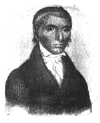Written by Between the Logs

The governor-general of Canada was outraged. Word arrived from Fort Detroit Commandant Delonguewell that a tribe of Hurons had allowed the British fort to be built at its principal village near the mouth of the “Sandosket” river in the of French-held territory.
The leader of these Wyandots, as they called themselves, was none other than Chief Orotony, or Nicholas, as the missionaries had baptized him. Described in written accounts as “a wily fellow, full of savage cunning, whose once aroused was greatly to be feared”, Nicholas had developed a hatred of the French while living near Detroit, Now the governor-general also learned of plans by Chief Nicholas to capture the French forts along the lakes and kill the inhabitants.
The roots of these events lie in the destruction of the Huron homeland, north of Lake Ontario by Iroquois League in 1649. This nation of people called themselves “Wendats,” a name the English would transform into “Wyandots.” The French called them Hurons, a somewhat derogatory reference to their trading practices.
Surviving Hurons fled westward to escape the Iroquois and settled in the Mackinac and Green Bay regions. Further reduced in numbers by disease and warefare, they were driven out by the Sioux and resettled in the Georgian Bay area, which the Iroquois by then had abandoned. They eventually moved to the vicinity of Detroit, a major trading area.
By the late 17th century, some “Wyandots already had begun moving to the southwest shore of Lake Eire. A clear river they called Outsandoukie, meaning “there is clear water there”, fed a large bay. A fortified village was erected by 1689 at the beginning of an overland portage connecting the bay with the mouth of the Portage river. Known then as the “carrying Place”, today the route is called Fulton street in Port Clinton, Ohio. This fortification established Wyandot control over the Carrying Place and was named Fort Sandoski..
Nicholas had become bitter over French affronts that likely were both real and imagined. Vowing to someday destory the French, he led his band of Wyandots to the south shore of Lake Erie around 1739. By 1744 Chief Orontony was in full control of Fort Sandoski.
Nicholas soon invited English traders from Pennsylvania to batter at his village. British guns, ammunition, manufactured goods and liquor were of better quality than items offered by the French. And the English offered better trading terms to retain Indian allegiance.
In 1745 the traders erected a fortified blockhouse and trading post at Fort Sandoski. It represented the first fort built by white men in Ohio territory and began the first clash between Britain and France for the control of Ohio.
Nicholas had further plans for dealing with the French. He called together members of the Hurons, Miamis, Ottawas, Shawnees, Chippewas, Sioux, Pottawattomies, and other tribes to plan attacks on Fort Detroit and other French forts in 1747. But the plan broke apart prematurely.
A group of French trappers had arrived at Fort Sandoski to trade pelts, unaware of the chiefs hostility. Nicholas became irritated at what he saw as audacity by Frenchmen entering the fort without his consent. He ordered the trappers seized and tomahawked.
At about the same time, an Indian woman overheard the tribal leaders planning the attacks on French forts and reported the scheme to a Jesuit missionary, who in turn informed the Fort Detroit commandant. These events spurred the French to send 150 troops immediately to reinforce Detroit. To gain immunity from French retribution, Nicholas promised to sever his British ties and expel the English from Fort Sandoski.
The promise was short lived.
During the winter of 1747-48, Nicholas again allowed Pennsylvania traders to operate at Fort Sandoski. Detrot Commandant DeLonguewill took immediate action, ordering French troops to forcefully suppress Nicholas and expel the British.
Sensing his own impending destruction, the chief ordered his villages pull down and had the stockade and building of the Fort Sandoski burned. With 119 of his warriors and their families in tow, Orontony of the Wyandots led his people to a new settlement on the White River in what is now Indiana. He later moved again to the bank of the Ohio River in Illinios where he died in 1748.
Your Brother
Between-the-Logs